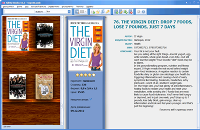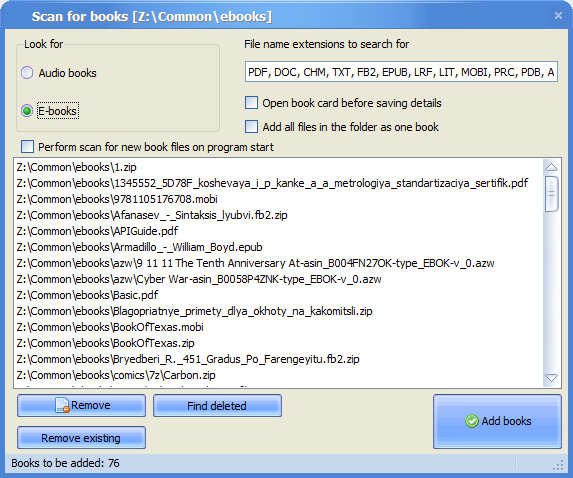How to organize e-books using All My Books


All My Books is an all-in-one book cataloger. Using this application, you can catalog e-books, printed books, or audiobooks. Read this article to learn how to catalog e-books. First, download and install All My Books. It's easy to do, just click the button below:
Add e-books to your catalog
You have probably installed and launched the application. What's next? Start creating your own book catalog! Most likely, the application opened a demo catalog with some dummy books. To get rid of them, press CTRL-A to select all books, and then press Delete to delete them.
If you need to add a few e-books to an existing collection, click "Book -> Add E-book..." in the menu or press CTRL-F2. The application will prompt you to specify the book files that you want to add to your collection. You can select multiple files to add them all at once.
All My Books will try to extract as much information as possible from the files being added. FB2, EPUB, and some other e-book formats usually contain enough information to fill the book card. In most cases, you don't have to manually enter each book's title and author, or look for its cover image because All My Books typically can do that for you! In the case of the PDF format, meta information is often less rich, but All My Books will try to help you anyway. It will use the first page of the document as a cover. You can also download more information about the book from certain websites. For more details, please read the article about cataloging printed books.
Now let's get down to the main part. Of course, you can add books to the collection one by one, but what if you have hundreds or even thousands of them? Don't worry, All My Books can help you! If you need to add many books, click "Book -> Scan drive/device for books..." in the menu. Specify a folder (or a whole disk) to search for e-book files of known formats. If you want to search for e-books on your e-reader device (for example, Kindle), make sure to connect it to the computer via USB before selecting the above menu item. In that case, All My Books will allow you to specify a folder on the device. Let's take a closer look at the Book Search dialog box:

In the dialog box, select "Audiobooks" or "E-books" (in this case, "E-books"). Basically, these are two file type sets. In the "File name extensions to search for" text field, you can enter file types to search for, separated by a comma. Add or remove file extensions from that text field as necessary, and then press Enter to repeat the search. The found files for adding to the collection are displayed in the list at the center of the dialog box. If you want to avoid adding some files from the list to your collection, select them, and then press Delete key or click the "Remove" button.
If some books from the scanned folder have already been added to the collection, there is no need to add them again, so click the "Remove existing" button. The application will remove any files that already exist in your collection from the list.
Occasionally, you may delete book files from the disk, but they may still be present in the All My Books collection. To remove all non-existing files from the catalog, click the "Find deleted" button. The application will check all books in your current collection for the existence of their respective files on the disk. If the application doesn't find the physical files, it will prompt you to remove the respective books from the collection.
All My Books supports automatic search for new e-book files. If you check the "Perform scan for new book files on program start" checkbox, each time you launch the application, it will scan the specified folder and prompt you to add the new books (if any). If you want to turn off this option, click "Book -> Scan drive/device for books..." in the menu and uncheck the checkbox.
If you check the "Open the book card before saving details" checkbox, you can manually add some information for each book (for example, a rating). Anyway, you can add more information later, after adding all the books to the catalog.
The "Add all files in the folder as one book" option is mostly useful when you need to add audiobooks that consist of multiple files. More details about cataloging audiobooks.
It should be noted that you can import an existing collection. For example, if you already have a book list in MS Excel, you can import it to All My Books by clicking "Tools -> Import from -> Import from MS Excel..." in the menu.
Now you know how to create a catalog of e-books using All My Books.
What's next?
When the book catalog is ready, you can fully enjoy its advantages!
- Launch a reader app for any book directly from the All My Books catalog! Click the "Open Book" button in the toolbar or in the book details area. All My Books will launch the application associated with the book's file type, as specified in the "Local path" field in the Book Card dialog box. In most cases, your favorite e-reader will be started (for example, AlReader3).
Here's a hint: If you need to quickly access the book's file, hold the Shift key while clicking the "Open Book" button. In that case, instead of launching an e-reader, the application will open the folder containing the files of the book. - All My Books can also copy books to any e-reader, smartphone, external hard drive, USB stick, etc. Just connect the device to your computer via USB and click "Tools -> Transfer books to device..." in the menu. Kindly note that All My Books cannot convert an e-book to a different format, so use it to copy only books in the formats supported by your e-reader.
- The application has an interesting feature: It can rename book files by using a template. If you want your files to have pretty standardized names, click "Tools -> Rename book files..." in the menu.
- To view statistics for your collection, click "Tools -> Statistics" in the menu or press F5. You can learn plenty of interesting things: The most popular genre in your collection, the most popular authors, the total number of books, and many more.
- You can easily find a book by using many search criteria. To search for a book, press F3. The application allows you to search by all catalog fields or by specified ones only.
- If you dislike the "grid" look of your collection, no problem! You can switch between the available catalog-displaying options by using the "View" menu. Hopefully, you will be impressed by the "Virtual shelf" and "Cover flow" modes.
- All My Books is a very flexible application. It allows you to view your catalog in different ways. For example, you can group books by genre, publisher, or other criteria. Just click "View -> Group books by" in the menu and specify the criteria.
Thank you so much for reading this article! Love books and read them!
Our customer say
"I am among those who people call bookworms - I've got too many books in my library - too many to count! I never even hoped to make them organized one day! I've been using All My Books for about a year now and can't help admiring it! Though it's got many functions and features, it's really easy to use. It's also very fast - it takes a few seconds to find a book in the database! In other words, it's just great! I have already recommended it to all my friends who love books like me and I they share my delight as well!!! Wow!!!! Thanks!"
Samuel Harris - Rating: 4.9 -